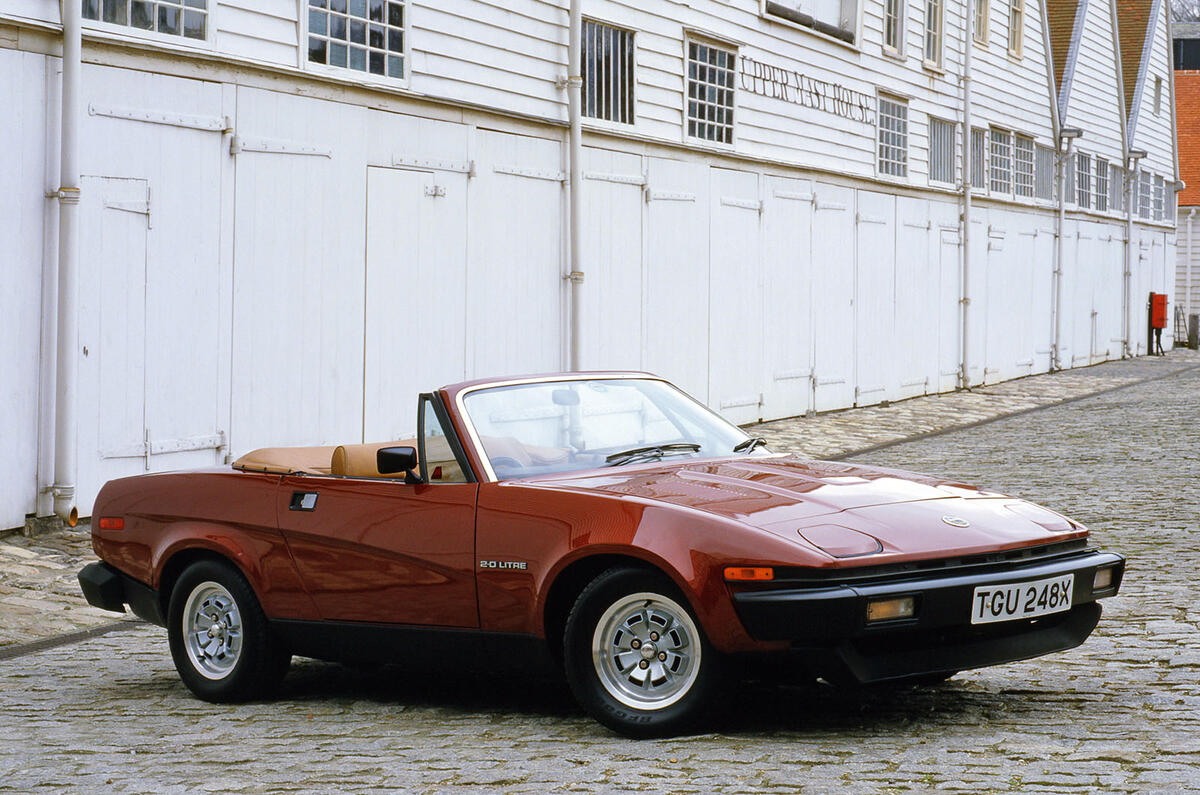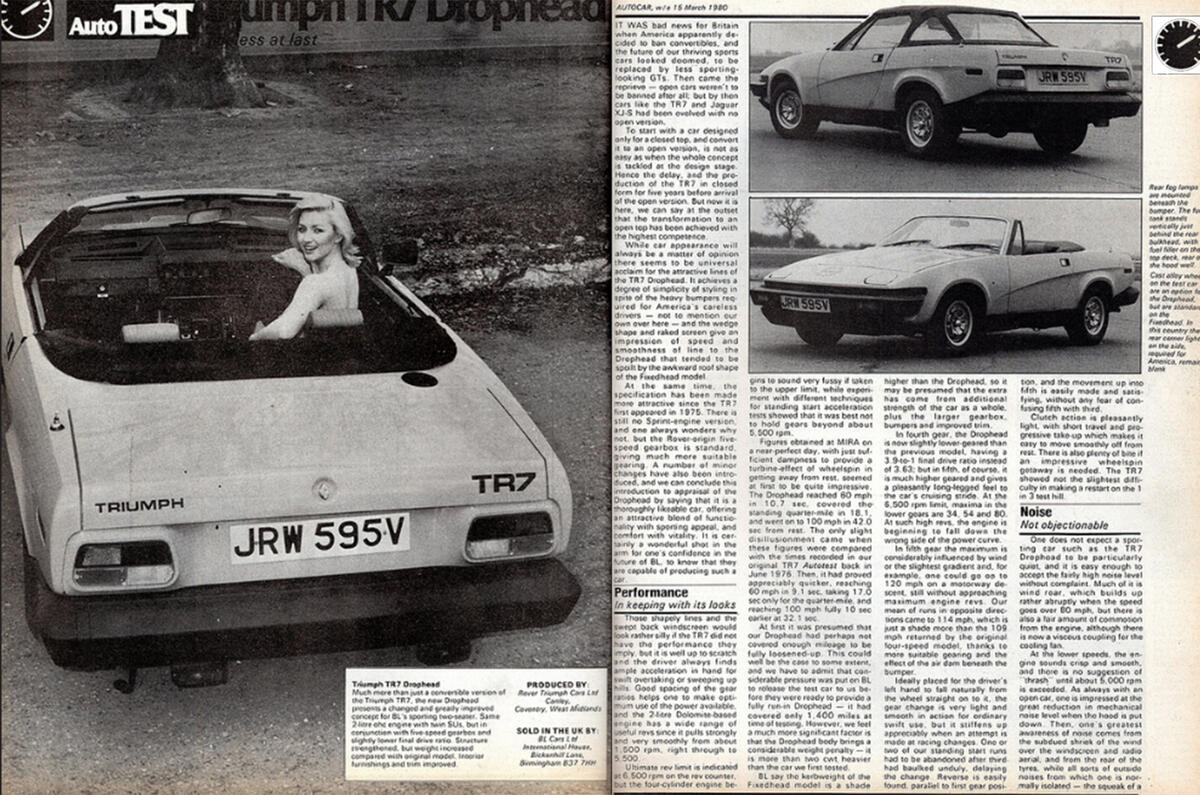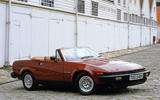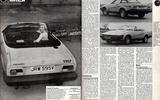Coventry-based manufacturer Triumph had more lives than a box of kittens during its tumultuous 95-year existence, with seemingly endless buy-outs and rebrandings before the factory doors closed for good in 1984.
However, the thought of Triumph models remains an evocative one, invoking memories of sports cars and sexy roadsters. Autocar’s review of the TR7 Drophead in 1980 embraced the car’s sex appeal with a tongue-in-cheek spread featuring a young lady whose dress code matched that of the topless TR7. It was a risqué reference that would have been at home in one of the Carry On films of the time.
The reference was more than innuendo, though, as was realised early on in the review. “Much more than just a convertible version of the Triumph TR7, the new Drophead presents a changed and greatly improved concept for BL’s sporting two-seater,” our tester wrote.
The Drophead introduced a five-speed manual gearbox with a lower final drive ratio than before, while some otherwise welcome structural strengthening had unavoidably added weight.
A ban on the sale of convertibles in the US at the time had led to Jaguar and Triumph only developing hard-top cars. However, once the ban was lifted, it took Triumph five years to transform the coupé into a convertible. “But now it is here, we can say from the outset that the transformation to an open-top has been achieved with the highest competence,” we reported.
On its looks, we felt there was “universal acclaim” for the attractive lines of the TR7 Drophead. “It achieves a degree of simplicity of styling in spite of heavy bumpers,” our tester wrote. “The wedge shape and raked screen give an impression of speed.”
Fortunately, there was substance to back up the style. “Those shapely lines and the swept-back windscreen would look rather silly if the TR7 did not have the performance they imply,” said our man, who found that the TR7 possessed ample acceleration for swift overtaking or tackling hills. We also thought there was “good spacing of the gear ratios” and the engine had “a wide range of useful revs”, pulling strongly and very smoothly as it did from about 1500rpm right through to 5500rpm.
Our tester thought that the gearlever was well positioned and easy to use, too. “It’s ideally placed for the driver’s left hand to fall naturally from the wheel straight on to it, and the gearchange is very light and smooth in action,” we said.
We also found that the TR7 understeered. “Cornering behaviour is consistent and reassuring until the car is pushed hard through corners,” continued our tester. “The general feel of the handling remains easily manageable, though, and the driver has confidence to corner hard without feeling that the car will respond unexpectedly and catch him out. Even when cornering very fast there is a minimum of body roll, helped by having an anti-roll bar at each end.”
We felt that the steering, meanwhile, was impeccable: precise and responsive to the smallest steering input.
“The driving position,” our tester said, “is exceptionally comfortable, with the chubby little steering wheel set at ideal arm’s length for most drivers, and with generous leg room and a range of seat adjustments.”
Elsewhere inside, we observed that the minor controls “are well arranged” and “the instruments clearly marked”.
Our verdict of the TR7 surmised the positivity: “It is in its all-round behaviour that the TR7 appeals, and although some of its competitors may match it for ultimate handling or offer a little more performance, it certainly achieves a very good blend of sporting handling with comfort, performance with economy, and interior space with external compactness. Though not cheap, it is also reasonably competitive on price.”
Matthew Griffiths
Previous Throwback Thursdays
2 April 1986 - Figuring the MG Metro 6R4 rally car
10 March 1979 - A Rover SD1 with a difference
4 September 1996 - The original Porsche Boxster driven
5 April 1986 - Audi Quattro vs Porsche 944 Turbo
16 May 1987 - Ford Escort XR3i Cabriolet
17 October 1981 - The £12,000 baby Aston Martin
16 January 1985 - The launch of the Sinclair C5
15 April 1960 - Porsche's four-cylinder roots
17 August 2004 - The Honda NSX's last hurrah
11 October 1986 - Hyundai's second UK market foray
Individual copies of Autocar with free next-day delivery can now be bought through Magsdirect.







Join the debate
Add your comment
In the beginning
The Brown colour apart....
Never been a fan of classic British Cars